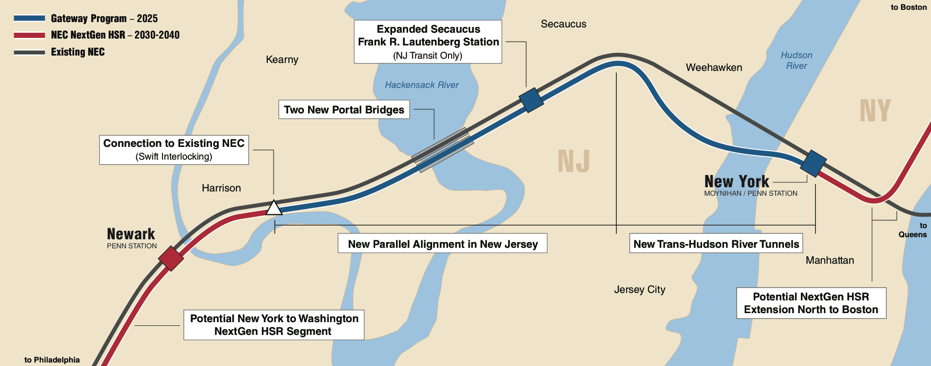Table of Contents
Download Planning for a New Northeast Corridor:

Download The Hudson Terminal Plan:

Download the Trends & Opportunities Report:

Amtrak’s Gateway Project
Amtrak’s Gateway Project seeks to double the number of tracks traveling from Newark, NJ to New York Penn Station from 2 to 4 by constructing a new rail tunnel beneath the Hudson River. The two new tracks would connect with existing trackage at Penn Station and would also connect with a new annex station south of the current Penn Station structure. Eventually, the Gateway Project’s tracks will become part of Amtrak’s next generation high speed rail line traveling from Boston to Washington, D.C. There have not been any feasibility studies completed at this time, but preliminary estimates put the total cost of the project at approximately $15 billion with a completion year of 2025.
The Gateway Project’s greatest advantage is the long term prospect of creating a modern high-speed rail network along the Northeast Corridor. As population grows in the northeast and gas prices rise, the demand for fast and efficient regional rail service will continue to increase, and the Gateway Project hopes to address this future transportation challenge. In addition, the Gateway Project will also presumably allow for a future connection to Grand Central Terminal’s East Side Access terminus, which would eventually allow trains originating in Washington, Baltimore, and Philadelphia to connect to both Penn Station and Grand Central Terminal before linking to Amtrak’s existing Northeast Corridor line via the Hell Gate Bridge. Despite these benefits, however, Amtrak’s Gateway Project has significant shortcomings considering the high costs and little minimal benefit for the metropolitan region. Amtrak has not proposed any means of bringing any of NJ Transit’s Hoboken Division rail lines into Penn Station. This lack of connectivity is especially troubling considering the significant increase in Manhattan workers living in northern New Jersey who still do not have access to a direct one-seat ride into New York City. The Gateway Project also fails to sufficiently prepare for the future growth of the metropolitan region’s transit systems, including a possible Manhattan link for NJ Transit’s Hudson-Bergen Light Rail, a new NJ Transit West Shore commuter line, and expanded ridership from the MTA’s Penn Station Access proposal. While the Gateway Project will one day help to usher in a new era of high-speed regional rail service throughout the northeast United States, today, the metropolitan region needs to capitalize on a number of more impactful, and much less expensive transit opportunities.

